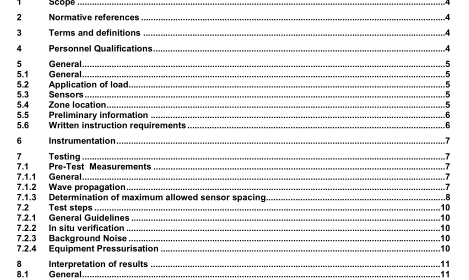EN 15495:2007 – Non Destructive testing – Acoustic emission – Examination of metallic pressure equipment during proof testing – Zone location of AE sources

5.5 Preliminary information
Prior to the test, the AE Test Organisation shall collect the following information:
a) relevant Product Standard;
b) type of equipment or structure and material characteristics and specifications;
c) design- and test pressure;
d) working- and test temperature;
e) assembly and/or layout drawings with sufficient details of the structure;
f) material specifications, including heat treatment; if applicable
g) proposed pressure/stress application sequence;
h) potential acoustic noise interference sources and the isolating mechanism applied;
i) where possible, locations of known discontinuities and the general results of prior NDT.
5.6 Written instruction requirements
The AE Test Organisation shall provide a written test instruction, which shall include but not necessarily be restricted to the following:
a) Test object (description and/or drawing, including area of interest and purpose of test);
b) limitations if any;
c) sensor type, frequency and manufacturer;
d) method of sensor attachment;
e) type of acoustic couplant used;
f) type of surface preparation;
g) type of AE equipment used with the main characteristics and settings;
h) energy measurement method to be used;
i) sensor location maps representing the structure or part of it;
j) description of equipment verification procedure;
k) description of the in-situ verification (see 7.2.2);
l) sequence of pressurisation;
m) recorded data and recording method;
n) available on-line presentation of data;
o) real time evaluation criteria;
p) post analysis procedure with adopted filtering technique if used;
q) final report requirements;
r) qualification/certification of the personnel;
s) value of K Z ,( for definition see Figure 1)
from the relevant Product Standard if available.
6 Instrumentation
An AE system consists of sensors and equipment for signal conditioning and processing and for displaying
and recording data according to EN 13477-1.
The AE instrument shall be capable of measuring at least the following parameters on all channels:
a) AE burst count;
b) Burst signal peak amplitude;
c) Burst signal duration;
d) Burst signal rise time;
e) Burst signal energy;
f) Arrival time;
and on external inputs pressure and/or other stress parameters.
To allow a real time control of the pressure equipment under test, the test instrumentation shall:
Store all the acquired AE data and the external parameter(s).
Provide an on-line activity vs channel display.
Provide an on-line activity vs zone display.
Provide an on-line display of AE data and pressure.
To assist the online evaluation it is recommended that the instrumentation provides data allowing real time AE noise identification. Online grading of zones is also recommended.
The AE system operating characteristics shall be verified according to EN 13477-2.
7 Testing
7.1 Pre-Test Measurements
7.1.1 General
The requirements listed in EN 14584 apply for a setup that uses both, planar and zone location. The following text is to be observed where planar location is not used.
EN 15495:2007 – Non Destructive testing – Acoustic emission – Examination of metallic pressure equipment during proof testing – Zone location of AE sources